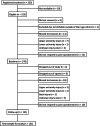Musculoskeletal pain and its association with health status, maturity, and sports performance in adolescent sport school students: a 2-year follow-up
- PMID: 35313966
- PMCID: PMC8939173
- DOI: 10.1186/s13102-022-00437-x
Musculoskeletal pain and its association with health status, maturity, and sports performance in adolescent sport school students: a 2-year follow-up
Abstract
Background: Musculoskeletal pain and its risk factors are rarely assessed in studies on adolescent athletes. The aim was to identify risk factors at baseline that were associated with the persistence or development of musculoskeletal pain at a two-year follow-up in adolescent sport school students, and to study cross-sectional associations at follow-up between musculoskeletal pain and sports performance.
Methods: Sport school students (79 boys and 52 girls, aged 14 years at baseline) were divided into infrequent (never-monthly) or frequent (weekly-almost daily) pain groups, based on frequency of pain using a pain mannequin. Logistic regression analyses were performed to study longitudinal associations between frequent pain at follow-up and baseline variables: pain group, number of regions with frequent pain, health status by EQ-5D, maturity offset (pre, average, or post peak height velocity), and sports (contact or non-contact). Linear regression analyses were used to study cross-sectional associations between pain groups and 20-m sprint, agility T-test, counter-movement jump, and grip strength at follow-up. Results were stratified by sex.
Results: A higher percentage of girls than boys reported frequent pain at follow-up (62% vs. 37%; p = 0.005). In boys, frequent pain at follow-up was associated with being pre peak height velocity at baseline (OR 3.884, CI 1.146-13.171; p = 0.029) and participating in non-contact sports (OR 3.429, CI 1.001-11.748; p = 0.050). In girls, frequent pain at follow-up was associated with having frequent pain in two or more body regions at baseline (OR 3.600, CI 1.033-12.542; p = 0.044), having a worse health status at baseline (OR 3.571, CI 1.026-12.434; p = 0.045), and participating in non-contact sports (OR 8.282, CI 2.011-34.116; p = 0.003). In boys, frequent pain was associated with worse performances in 20-m sprint and counter-movement jump, but not in agility T-test and grip strength.
Conclusions: Baseline risk factors for having frequent pain at follow-up were late maturation in boys, frequent pain and worse health status in girls, and participation in non-contact sports in both sexes. Boys with pain performed worse in sports tests. Coaches and school health-care services should pay attention to the risk factors and work towards preventing pain from becoming persistent.
Keywords: Epidemiology; Exercise physiology; Health status; Maturity; Sports performance.
© 2022. The Author(s).
Conflict of interest statement
The authors declare that they have no competing interests.
Similar articles
-
Associations between pain, health, and lifestyle factors in 10-year-old boys and girls from a Swedish birth cohort.BMC Pediatr. 2023 Jun 29;23(1):328. doi: 10.1186/s12887-023-04139-2. BMC Pediatr. 2023. PMID: 37386396 Free PMC article.
-
Musculoskeletal pain and its association with maturity and sports performance in 14-year-old sport school students.BMJ Open Sport Exerc Med. 2018 Jul 3;4(1):e000395. doi: 10.1136/bmjsem-2018-000395. eCollection 2018. BMJ Open Sport Exerc Med. 2018. PMID: 30018793 Free PMC article.
-
[The assessment of biological maturation for talent selection - which method can be used?].Sportverletz Sportschaden. 2015 Mar;29(1):56-63. doi: 10.1055/s-0034-1399043. Epub 2015 Feb 24. Sportverletz Sportschaden. 2015. PMID: 25710395 German.
-
Worse health status, sleeping problems, and anxiety in 16-year-old students are associated with chronic musculoskeletal pain at three-year follow-up.BMC Public Health. 2019 Nov 27;19(1):1565. doi: 10.1186/s12889-019-7955-y. BMC Public Health. 2019. PMID: 31771551 Free PMC article.
-
American Medical Society for Sports Medicine position statement: concussion in sport.Br J Sports Med. 2013 Jan;47(1):15-26. doi: 10.1136/bjsports-2012-091941. Br J Sports Med. 2013. PMID: 23243113 Review.
Cited by
-
Changes in Athletic Performance in Children Attending a Secondary School with a Physical Activity Profile.Sports (Basel). 2022 May 2;10(5):71. doi: 10.3390/sports10050071. Sports (Basel). 2022. PMID: 35622480 Free PMC article.
-
Associations between pain, health, and lifestyle factors in 10-year-old boys and girls from a Swedish birth cohort.BMC Pediatr. 2023 Jun 29;23(1):328. doi: 10.1186/s12887-023-04139-2. BMC Pediatr. 2023. PMID: 37386396 Free PMC article.
References
-
- McMahon EM, Corcoran P, O'Regan G, Keeley H, Cannon M, Carli V, Wasserman C, Hadlaczky G, Sarchiapone M, Apter A, et al. Physical activity in European adolescents and associations with anxiety, depression and well-being. Eur Child Adolesc Psychiatry. 2017;26(1):111–122. doi: 10.1007/s00787-016-0875-9. - DOI - PubMed
-
- Paananen MV, Auvinen JP, Taimela SP, Tammelin TH, Kantomaa MT, Ebeling HE, Taanila AM, Zitting PJ, Karppinen JI. Psychosocial, mechanical, and metabolic factors in adolescents' musculoskeletal pain in multiple locations: a cross-sectional study. Eur J Pain. 2010;14(4):395–401. doi: 10.1016/j.ejpain.2009.06.003. - DOI - PubMed
-
- Holden S, Rathleff MS, Roos EM, Jensen MB, Pourbordbari N, Graven-Nielsen T. Pain patterns during adolescence can be grouped into four pain classes with distinct profiles: a study on a population based cohort of 2953 adolescents. Eur J Pain (London, England) 2018;22(4):793–799. doi: 10.1002/ejp.1165. - DOI - PubMed
Grants and funding
LinkOut - more resources
Full Text Sources


